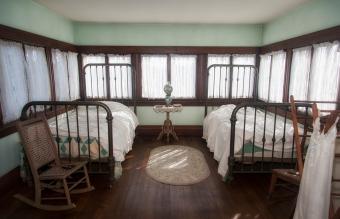
If you're wondering whether your find is really brass, it helps to learn a bit about what antique brass looks like. That way, you can determine the metal content and sometimes even the age of your treasure.
Is Your Item Solid Brass?
Sometimes, antique items are made of solid brass, but it's also common to find pieces that are plated or wrapped in a thinner layer of brass. You can tell the difference with the help of a magnet. If you hold a magnet against the item and feel a pull, you know the piece is brass plated. If there's no attraction, then the piece is solid brass. That's because the underlying metal is usually iron or steel, both of which are magnetic.
Typical Features of Antique Brass
You'll see antique brass in the form of candlesticks, lamps, such as the base of some antique oil lamps, vases, beds, musical instruments, and more. Identifying it can be tricky for several reasons, however. Sometimes, brass has been lacquered to prevent tarnishing. Other times, it's been painted to change the style. How the brass has been stored can also affect its appearance dramatically. Understanding the features of antique brass can help you identify it.
Color - Red to Yellow
You can expect to see variation in the color of antique brass items. Brass is an alloy, which means it is made up of more than a single metal. In the case of brass, that combination is zinc and copper, and there's no set formula for how much of each metal is in the brass. For applications where strength is an issue, such as cabinet hardware or doorknobs, the brass often includes more zinc and has a yellow tone when polished. In decorative applications or even jewelry, the brass may contain less zinc and have a warmer, even reddish, tone. In some cases, such as marine hardware or screws, the brass includes tin in the alloy to help prevent corrosion.

Tarnish - Surface Oxidation
Antique brass pieces often display tarnish, unless they have been cleaned. Because brass is made up of zinc and copper, it tends to tarnish or oxidize. This happens because the metals in the brass react with skin oils and the oxygen in the air. Tarnish is often mottled with spots of various colors like red, black, brown, and gray. Over time, it can become very thick and cover the entire brass item with a dark coating. This tarnish is normal for antique brass, and you can clean it off if you wish.

Sometimes Lacquered
Some brass items are lacquered to prevent them from tarnishing. However, over time, this lacquer can wear away or flake off. If you have an antique item with a lacquered brass finish, it may show uneven wear and areas of tarnish. The laquering process has been around since at least the 19th century, and older lacquered pieces tend to show patches of dullness or even small cracks or crazing.

Maker's Marks
Some antique brass pieces feature stamps or maker's marks to help identify where and when they were made. Look for these marks on the bottoms or backs of your brass antiques - they may appear as a collection of numbers, letters, or symbols. OldCopper.org has a good listing of various maker's marks to compare.
Painted Brass
Painted brass can be difficult to spot. In some eras, brass was a less popular finish. When it went out of style, owners would paint the pieces, rather than discarding them. These painted items look virtually identical to other painted metal. However, if you are able to flake or scrape off a little of the paint, you can sometimes reveal the brass beneath it. Removing the paint can help restore the item to its original state.
Restored Brass
Some brass antiques have required restoration over the years. Sometimes, the lacquer coating is stripped to remove the uneven surface. Generally, this does not affect the value of the item. In other cases, the piece must be soldered to reinforce its structure or repair damage. You can see more recent solder marks if you look closely at a restored piece. In general, skillful restoration isn't something you can notice at a glance.
Modern Antique Brass Finishes
You can buy cabinet hardware, doorknobs, plumbing fixtures, and more in an antique brass finish. Typically duller and more subtle than shiny brass, antique brass offers an understated touch for interiors. If you need to determine whether something is an antique or whether it's a modern item with an antique brass finish, look for signs of wear. A uniform surface and signs of recent machine manufacturing indicate a modern piece with an "antique" finish.

Learn More About Your Find
Whether your item is antique brass or not, it's fun to learn more about its age and history. Now that you know the materials, you can find out more about what your antique find might be.







